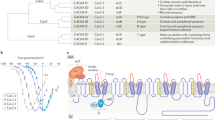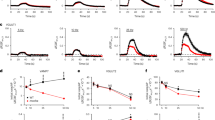Abstract
MODULATION of transmitter release underlies several forms of learning-related synaptic plasticity, including presynaptic facilitation and long-term potentiation1–4. Although the presynaptic terminals of most neurons are not accessible for direct study, it has often been possible to correlate changes in calcium influx in the cell body, owing to modulation of K+ or Ca2+ channels, with changes in release5–7. Some forms of presynaptic plasticity, however, do not involve changes in Ca2+ influx8–12. Moreover, the presence of multiple types of K+ and Ca2+channels with different subcellular distributions makes the direct measurement of Ca2+ influx into presynaptic terminals essential. Using synapses recon-stituted in culture between Aplysia sensory and motor neurons13, we have imaged Ca2+ influx in presynaptic terminal regions in response to action potentials, and demonstrate that presynaptic facilitation produced by 5-hydroxytryptamine involves enhanced Ca2+ influx through dihydropyridine (DHP)-insensitive Ca2+ channels14 present near release sites. This increased influx is attributable to spike broadening and is significantly correlated with the magnitude of presynaptic facilitation. By contrast, DHP-sensitive channels appear to aid the recovery from depression due to high-frequency stimulation.
This is a preview of subscription content, access via your institution
Access options
Subscribe to this journal
Receive 51 print issues and online access
$199.00 per year
only $3.90 per issue
Buy this article
- Purchase on Springer Link
- Instant access to full article PDF
Prices may be subject to local taxes which are calculated during checkout
Similar content being viewed by others
References
Hawkins, R. D., Kandel, E. R. & Siegelbaum, S. A. A. Rev. Neurosci. (in the press).
Castellucci, V. F. & Kandel, E. R. Science 194, 1176–1178 (1976).
Bekkers, J. M. & Stevens, C. F. Nature 346, 724–729 (1990).
Malinow, R. & Tsien, R. W. Nature 346, 177–180 (1990).
Dunlap, K. & Fischbach, G. D. Nature 276, 837–839 (1978).
Klein, M. & Kandel, E. R. Proc. natn. Acad. Sci. U.S.A. 77, 6912–6916 (1980).
Lipscombe, D., Kongsamut, S. & Tsien, R. W. Nature 340, 639–642 (1989).
Man-Son-Hing, H., Zoran, M. J., Lukowiak, K. & Haydon, P. G. Nature 341, 237–239 (1989).
Dale, N. & Kandel, E. R. J. Physiol., Lond. 421, 203–222 (1990).
Hochner, B., Klein, M., Schacher, S. & Kandel, E. R. Proc. natn. Acad. Sci. U.S.A. 83, 8794–8798 (1986).
Delaney, K., Tank, D. W. & Zucker, R. S. J. Neurosci. 11, 2631–2643 (1991).
Malgaroli, A. & Tsien, R. W. Nature 357, 134–139 (1992).
Rayport, S. G. & Schacher, S. J. Neurosci. 6, 759–763 (1986).
Edmonds, B., Klein, M., Dale, N. & Kandel, E. R. Science 250, 1142–1147 (1990).
Braha, O., Edmonds, B., Klein, M., Sacktor, T. & Kandel, E. R. J. Neurosci. (in the press).
Hochner, B., Klein, M., Schacher, S. & Kandel, E. R. Proc. natn. Acad. Sci. U.S.A. 83, 8410–8414 (1986).
Siegelbaum, S. A., Camardo, J. S. & Kandel, E. R. Nature 299, 413–417 (1982).
Baxter, D. A. & Byrne, J. H. J. Neurophysiol. 62, 665–679 (1989).
Mercer, A. R., Emptage, N. J. & Carew, T. J. Science 254, 1811–1813 (1991).
Byrne, J. H. J. Neurophys. 48, 431–438 (1982).
Grynkiewicz, G., Poenie, M. & Tsien, R. Y. J. biol. Chem. 260, 3440–3450 (1985).
Blumenfeld, H., Zablow, L. & Sabatini, B. Biophys. J. 63, 1146–1164 (1992).
Blumenfeld, H., Spira, M. E., Kandel, E. R. & Siegelbaum, S. A. Neuron 5, 487–499 (1990).
Dodge, F. A. & Rahamimoff, R. J. Physiol., Lond. 193, 419–432 (1967).
Smith, S. J., Augustine, G. J. & Charlton, M. P. Proc. natn. Acad. Sci. U.S.A. 82, 622–625 (1985).
Braha, O. et al. Proc. natn. Acad. Sci. U.S.A. 87, 2040–2044 (1990).
Gingrich, K. J. & Byrne, J. H. J. Neurophysiol. 53, 652–669 (1985).
Ghirardi, M. et al. Neuron 9, 479–489 (1992).
Nerbonne, J. M. & Gurney, A. M. J. Neurosci. 7, 882–893 (1987).
Glanzman, D. L., Kandel, E. R. & Schacher, S. Neuron 3, 441–450 (1989).
Author information
Authors and Affiliations
Rights and permissions
About this article
Cite this article
Eliot, L., Kandel, E., Siegelbaum, S. et al. Imaging terminals of Aplysia sensory neurons demonstrates role of enhanced Ca2+ influx in presynaptic facilitation. Nature 361, 634–637 (1993). https://doi.org/10.1038/361634a0
Received:
Accepted:
Issue Date:
DOI: https://doi.org/10.1038/361634a0
This article is cited by
-
The Role of Intracellular Calcium in Changing of ElectricalCharacteristics of Premotor Interneurons in Intact Snails and Snails During Various Forms of Plasticity
BioNanoScience (2019)
-
Protein kinase C acts as a molecular detector of firing patterns to mediate sensory gating in Aplysia
Nature Neuroscience (2012)
-
Electrophysiological Studies of the Effects of Chronic Administration of Caffeine on the Formation of a Conditioned Defensive Reflex in the Common Snail
Neuroscience and Behavioral Physiology (2009)
-
Voltage gated calcium channels in molluscs: classification, Ca2+ dependent inactivation, modulation and functional roles
Invertebrate Neuroscience (1996)
-
Modulation of ion currents and regulation of transmitter release in short-term synaptic plasticity: The rise and fall of the action potential
Invertebrate Neuroscience (1995)
Comments
By submitting a comment you agree to abide by our Terms and Community Guidelines. If you find something abusive or that does not comply with our terms or guidelines please flag it as inappropriate.



